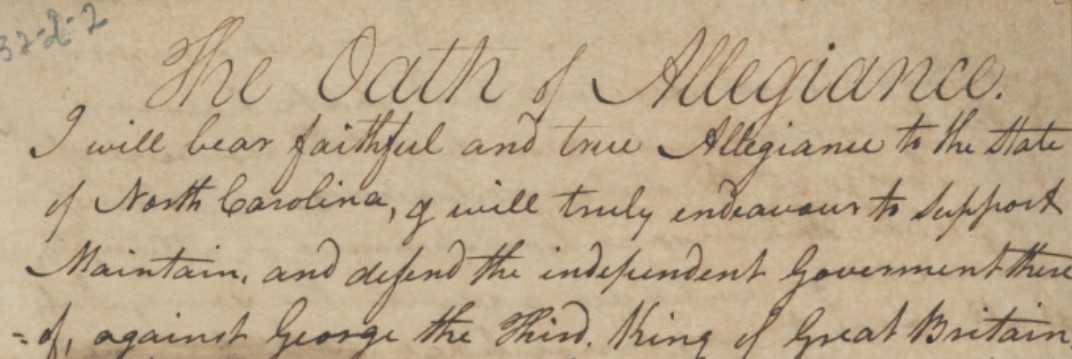Aftermaths & Legacies of the Gourd Patch Affair
Was the Gourd Patch Conspiracy a Loyalist Uprising?
A fervent desire to defend and promote Protestantism might make someone a zealot, but it does not necessarily make them a loyalist. Nothing in the formation of John Lewelling's original secret religious society suggested that he meant to become a loyalist. Instead, only as the movement snowballed towards violence, and as the State of North Carolina made their own judgements of Lewelling's intentions, did Lewelling and his associates become loyalists. Still, each member's fealty to the king was a personal decision and the vast majority of former associators successfully reintegrated themselves into Patriot society once the charges against them were dropped. George Ward, a resident of Bertie, was implicated in the plot, but his name appeared on a county-wide Oath of Allegiance a year later. Isaac Barbree, one 's the plots most violent members who had assisted in planning several assassination plots, later enlisted in the Continental Army.
Statewide Oaths of Allegiance
In the aftermath of the Gourd Patch Conspiracy trials, the state continued to enforce the recent law requiring all white adult men in the area to take the Oath of Allegiance to the State of North Carolina. If they refused, they'd be considered a loyalist and might be asked to leave the state within sixty days or forfeit their property.
Every county was divided into districts, and local officials were responsible for collecting oaths from every man in their assigned area. It was also noted if men refused the oath and what reasoning they might have had if that was the case. Taken in total, these oath of allegiance lists of men who signed and refused to sign is an important collection of historical documents. Not only do they act as a sort of census for Bertie, Martin, and Chowan during the tumultuous time of the American Revolution, but the list also helped many average individuals appear in the historical record who might not have done so otherwise.
The Lewelling-Mayo Feud
John Lewelling Mayo's name as written on Nathan Mayo's will.
Nathan Mayo, by helping Mary Lewelling get an audience with Richard Caswell, likely helped save John Lewelling's life. And Mayo's forgiveness wasn't a momentary blip either. When John Lewelling died in 1793, he named Nathan Mayo as one of the executors of his will. Further, Lewelling's daughter Susannah married Mayo's son Frederick, and the pair named their son John Lewelling Mayo, evidence that any old feuds were long since forgiven. Later when Frederick died, Susannah remarried to her brother-in-law, Nathan Mayo Jr.
Conclusion
So the Gourd Patch Affair came to an end. As it turned out, there were no assassinations, no executions. Still, the events in a rural Martin County pumpkin patch had an important effect on North Carolina's new government. By granting a pardon, Caswell strengthened the power of the executive and defined one of the governor's roles in the new government. Further, it made state leaders aware of just what a tenuous hold they had on state authority. The Gourd Patch Conspiracy had been thwarted, but the event taught state leaders that in the future they'd need a mix of authority and compromise in order to keep the state together and prevent future uprisings.
For Further Reading
Cogliano, Francis D. No King, No Popery: Anti-Catholicism in Revolutionary New England. Westport, CT: Greenwood Press, 1995.
Crow, Jeffrey J. "Tory Plots and Anglican Loyalty: The Llewelyn Conspiracy of 1777." North Carolina Historical Review, Vol. 55, No. 1 (Jan 1978) 1-17.
Freeze, Gary. "Like A House Built Upon Sand: The Anglican Church and Establishment in North Carolina, 1765-1776." Historical Magazine of the Protestant Episcopal Church, Vol. 48, No. 4 (Dec 1979) 405-432.
Holton, Woody. Forced Founders: Indians, Debtors, Slaves & the making of the American Revolution in Virginia. Chapel Hill: University of North Carolina Press, 1999.
McConville, Brendan. The Brethren: A Story of Faith and Conspiracy in Revolutionary America. Cambridge: Harvard University Press, 2021.
Thomas, Gerald W. Rebels and King's Men: Bertie County in the Revolutionary War. Raleigh: North Carolina Department of Cultural Resources, 2013.
Troxler, Carole Watterson. The Loyalist Experience in North Carolina. Raleigh: NC Department of Cultural Resources, 1976.


